
Accompaniment with the cuatro
Content
Strumming and rhythmicStrum variation techniques
2/4 strumming variants
3/4 strumming variants
4/4 strumming variants
6/8 strumming
Arpeggios. Accompaniment with arpeggios
Rhythm by arpeggios for 2/4 measures
Rhythm by arpeggios for 3/4 measures
Rhythm by arpeggios for 4/4 measures
Rhythm by arpeggios for 6/8 measures
Expansion of cuatro chord families
Expansion of cuatro chord families for major tonalities
Examples of use of cuatro chords families for major tonalities
Expansion of cuatro chord families for minor tonalities
Examples of use of cuatro chords families for minor tonalities
Adding notes to cuatro triads
Adding notes to cuatro seventh chords
Altering notes of cuatro chords
Cuatro chords inversions. Chord equivalence
The cuatro, being a small-sized instrument with only four nylon strings in which chord fingering is facilitated, stands out in the accompaniment of melodies through its strumming. Most of this page is devoted to the study of this type of accompaniment, but accompaniment is possible through other techniques that will be discussed at the end of this page. In any case, the accompaniment must be faithful to the organization of the melody in time, therefore the first section of this chapter deals with the basic aspects of this organization, therefore it is important to be clear about the concepts studied in the section dedicated to the musical time in the Theory page.
At this point you already have the basic knowledge to play a lot of simple popular melodies. This page will provide you with additional knowledge to help you become more than a beginner.
Strumming and rythmic
In the Chord strumming accompaniment part of the Chords section of this page it was suggested to use the following basic accompaniment patterns. For melodies with 2/4 metrics:

For melodies with 4/4 metrics:

For melodies with 4/4 metrics:

Quite rightly, these schemes may have seemed extremely monotonous to you, but they have the virtue, because they are strictly subject to the metrics of these measures, of helping you grasp and respect this metric as you perform the accompaniment: to adjust your internal clock. The beats of these accompaniment reveal sonorously the pulses of the metric, which conceptually exist even if the piece is not accompanied.
Strum variation techniques
Below are some of the most common strumming patterns, which we will group by measures types. All the patterns considered are derived from the basic patterns by using the following techniques:
- Increase in the number of strum strokes (division of beat times).
- Omission of strumming in some of the times or parts of a measure.
- Prolongation of the sound of a strum blow corresponding to a weak time or the weak part of a time to the strong time that follows or to the strong part of this time.
Observe how the rhythm varies when using different patterns, you will have to choose the ones you consider most appropriate and like best to create your own accompaniment style.
2/4 strumming variants
If we divide the second time of the basic strumming for 2/4 measures we get the strumming:

Let's listen to the result of using this strum in "Row, Row, Row Your Boat":
The following recording will allow you to familiarize yourself with this strumming:
If we also divide the first time of the basic strumming for measures of 2/4 in a eighth note and two sixteenth notes, we obtain the strumming:

Let's listen to the result of using this strum in "Tres Hojitas Madre", whose score-tablature is:
The following recording will allow you to familiarize yourself with this strumming. Note that a first introductory measure with two quarter notes that marks the tempo is used, so you must count one-two and then enter the strum. In the strumming, three measures are used with the Dm chord, then one with the Gm chord and finally another three with Dm, but in your practice you could use only Dm chords:
3/4 strumming variants
If we divide the third time of the basic strum for 3/4 measures in eighth notes, we obtain the following strum:

Here's this strum applied to a chord progression:

The following recording will allow you to familiarize yourself with this rasgueo:
In the subsection Basic chord families de la página Chords section we considered the interpretation of "Amazing Grace" using the basic strumming for 3/4 rhythms. Let's hear the result of using this strum variant to this melody:
If in the previous variant we divide the second time in eighth notes and also link the first stroke of this division with that of the first time we get:

Next this strum applied to a chord progression:

Let's listen to the result of using this variant of strumming to "Amazing Grace":
If in the previous variant the second part of the third time is replaced by a silence:

Here's this strumming applied to a chord progression:

Let's listen to the result of using this variant of strumming to "Amazing Grace":
4/4 strumming variants
We will use the melody "Oh Susanna", whose score-tablature is shown below, to illustrate different variants of the 4/4 strumming.
If we divide the second and fourth strokes of the basic strum for 4/4 measures in eighth notes, we obtain the following strum:

Let's listen to the result of using this strum in "Oh, Susanna":
The following recording will allow you to familiarize yourself with this strumming:
In the strumming we have just studied the division was made on the weak beats of the compass. If no distinction is made between strong beats and weak beats and any number of them is selected to perform time division, another 13 variants will be obtained.
The second technique to achieve variation in the rhythm is to omit a strumming stroke in one of the times of the measure or parts of these times. Let's try the elimination of the corresponding third-time strike of the previous strum.

Since the third beat is also a strong beat, although to a lesser extent than the first beat, this change should have a suspense effect on the rhythm, especially in those measures in which the melody does not contain a note in this third beat. Let's see:
Let's listen the result of using this strumming in "Oh, Susanna":
We will use the melody "Yellow Bird" to illustrate another variant:
The third technique to achieve variation in the rhythm is to prolong the sound of a strumming beat corresponding to a weak time or the weak part of a time to the strong time that follows or to the strong part of this time. Let's try the following modification of the 4/4 measure with split second and fourth beats:

Let's listen to the result of using this strum in "Yellow Bird":
The following recording will allow you to familiarize yourself with this strumming:
6/8 strumming
Remember that, according to what is studied in the subsection Classification of measures of the Theory/Musical time, the musical metric establishes that the measures are divided into two, three or four times, and each of these times must correspond to a whole, a half, or a quarter note. In the 2/4, 3/4 and 4/4 strums each beat has the duration of a quarter note, so we had no problems dividing each one of these beats between two to obtain variations of the strumming. To be able to divide the beats by three it is necessary that each of them has a duration of of a dotted whole note, a dotted half note, a dotted quarter note or a dotted eighth note. Take the case of the 2/4 measures:

Each of the beats has a duration of black, so dividing by three each of the resulting pulses would have a duration of 1/3; but this duration cannot be expressed by any of the figures in the musical notes. To be able to divide the times of a measure by three it is necessary that each one of them has a duration of a dotted whole note, a dotted half note, a dotted quarter note or a dotted eighth note. This change in the length of the beats in the 2/4 measures results in 6/8 measures:

The basic strum for melodies with metric of six by eight is:

Here's this strumming applied to a chord progression:

Let's listen the result of using this basic strumming to the simple arrangement given in the score and tablature of "Da Lounge Bar" that follows:
If we combine the first and second strokes of the basic strum for 6/8 measures in a single stroke with quarter note duration we get the following rasgueo:

Here's this strumming applied to a chord progression:

The following recording will allow you to familiarize yourself with this strumming:
Let's listen to the result of using this strum at "Da Lounge Bar":
If we combine the first and second strokes of the basic strum for 6/8 measures in a single stroke with quarter note duration we get the following rasgueo:

Here's this strumming applied to a chord progression:

The following recording will allow you to familiarize yourself with this strumming:
Let's listen to the result of using this strum at "Da Lounge Bar":
Arpeggios. Accompaniment with arpegios
In the previous sections we dealt with the accompaniment of melodies by strumming chords. In this section we will deal with the accompaniment of melodies through the use of arpeggios, which consist in the execution of the chord notes not simultaneously, but in succession. Just as the location and duration of strumming strokes within a measure make up the rhythm used in the accompaniment, the location and duration of the notes of the arpeggios within a measure also set the rhythm in the accompaniment by arpeggios. The use of arpeggios provides an appreciable number of accompaniment possibilities: if in each of the arpeggios the four strings of the cuatro are pressed following a basic scheme of notes of equal duration strictly adhered to the rhythm used in the piece, there would be 24 (4 x 3 x 2 x 1) different execution sequences; the variants introduced in the duration and position of the notes extend the possibilities to hundreds.
In its most basic form, strumming could be performed through the exclusive use of the side of the thumb or the fingernail of the index; arpeggio accompaniment implies the use of several fingers of the right hand. Several techniques can be used for the use of this hand, in this work we will consider two of the main ones. In the first four fingers are used: the thumb (p) to pluck the fourth string (A), the index (i) to pluck the third string (D), the middle finger (m) to pluck the second string (F#) and the ring (a) to press the first string (B). In the second, only the three strongest and easiest to control fingers are used: the thumb (p) is used to alternately pluck the fourth (A) and third (D) strings, the index to pluck the second (F#) and the middle finger to pluck the first string (B). You should practice both techniques until you can execute them with ease, so that you can choose for each particular piece the one you consider most appropriate, but regardless of the chosen one you should be careful to perform the accompaniment evenly over time.
Since, as we have mentioned, the possible variants when using rhythmic accompaniment by arpeggios are very numerous, we will not attempt an exhaustive treatment of this form of accompaniment; we will limit ourselves to presenting examples that serve to illustrate some basic ideas to elaborate this type of accompaniment. We will use the following methodology:
- The accompaniment of 2/4, 4/4, 3/4 and 6/8 measures are treated separately.
- For each of the melodies considered for each of the types of measures, an arrangement of notes adjusted to the bar indication is considered first: two black, four black, three black or six eighth notes.If necessary, these notes are distributed in more than one compass.
- If the result of the previous arrangement is not satisfactory, the duration and location of the arpeggio notes are modified, using the same techniques used for the generation of the strumming variants, until a satisfactory arrangement is obtained.
- The following order of string pulsation is favored: third, second, fourth and first, so that they are played in the ascending order of their open notes: A3, B3, D4 and F#4. The sequences will be identified by the order of pulsation of string strings, therefore this sequence will be identified as sequence 4132.If this sequence does not produce a satisfactory result, or it is desired to experiment, the strings will be tested using sequence 2314; that is, in the descending order of their open air notes: F#4, D4, B3 and A3.You can also try other alternate schemes, for example the 4321 sequence, the easiest to execute.
Rhythm by arpeggios for 2/4 meassures
Since the 2/4 measures have a duration of only two quarter notes, two of these measures are required to pluck the four strings of the cuatro when arpeggiatiing chords with notes of this duration. In the event that a chord occupies a single measure, the first two notes of the arpeggio are pressed on the first measure and the last two on the next measure.
Consider the use of strings sequence 4132 with equally spaced quarter notes in the accompaniment of "Tres hojitas madre" with arpeggios:
There is a more satisfactory arrangement of "Three mother leaves" if instead of quarter notes eighth notes are used in the accompaniment by arpeggios, which allows to press four notes of the arpeggio for the same chord in each measure:
To practice this new version of the accompaniment of "Tres hojitas madre" you can use the following progression of the chords used in its harmonization:
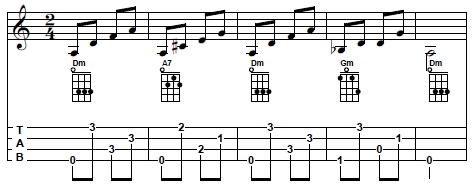
Rhythm by arpegio for 3/4 measures
Since the 3/4 measures have a duration of three quarter notes, if notes of this duration are used to execute the notes of an arpeggio on the four strings of the ukulele, a meassure is required for the first three notes and the first beat of the next measure for the fourth note. An alternative solution that allows you to limit the arpeggio to a single measure is to use some notes with durations shorter than a quarter note one; this is the strategy we will use in this section.
Consider the use of string sequence 4132 in the arpeggio accompaniment of "Amazing Grace":
As a preparatory practice for the accompaniment of "Amazing Grace" you can use the following progression of the chords used in your harmonization:

Rhythm by arpeggio for 4/4 measures
Since the 4/4 measures have a duration of four quarter notes, you can pluck the four strings of the cuatro used in an arpeggio in each of these measures.
Consider the use string sequence 4132 with equally spaced quarter notes notes in the accompaniment of "When The Saints Go Marching In" with arpeggios:
As a preparatory practice for the accompaniment of " When The Saints Go Marching In " you can use the following progression of the chords used in its harmonization:
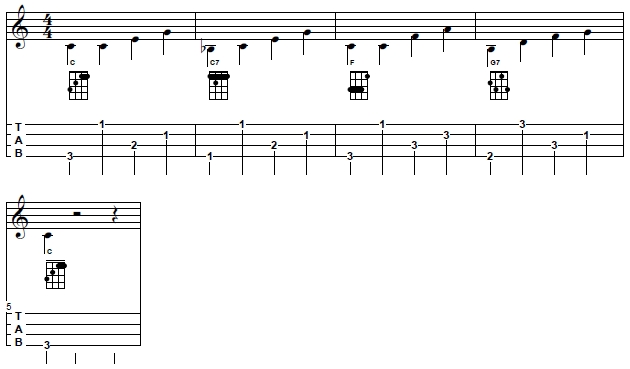
Observe que debe contar dos compases antes de iniciar su acompañamiento. El primero está constituido por cuatro tics de metrónomo y el segundo por un silencio y las tres primeras notas de la melodía.
Although the previous accompaniment is satisfactory and easy to execute, the repetition of the 4132 sequence for each measure using eighth notes results in an arrangement that is sonorously richer. Therefore, although technically it is more demanding because it requires faster execution, you may prefer it. The application of this scheme in the first three measures of "When The Saints Go Marching In" is illustrated below: the rest of the accompaniment only varies to fit the chords used in the following measures.
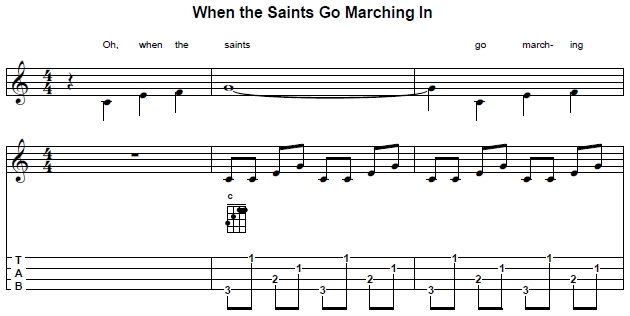
As a preparatory practice of this new version for the accompaniment of "When The Saints Go Marching In" you can use the following progression of the chords used in its harmonization:
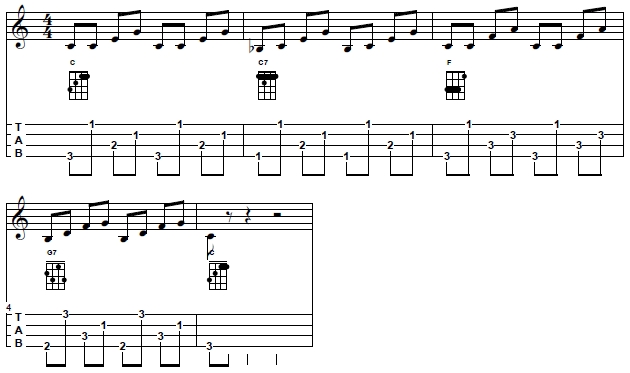
Rhythm by arpeggio for 6/8 measures
The three previous sections dealt with simple measures, in this section we will discuss 6/8 measures. In the 2/4 and 3/4 measures we had to decide how to fingerpick four-note arpeggios on measures that included less than four quarter notes; in the 6/8 measures we have six eighth notes per measure and we must decide how to distribute the four-note arpeggios on these measures.
Consider the use of string sequence 4132 in the accompaniment by arpeggios of "Da Lounge Bar":
In this arrangement the arpeggios have been distributed on a single measure by using a duration of a dotted black for their first note.
As a preparatory practice for the accompaniment of "Da Lounge Bar" you can use the following progression of the chords used in its harmonization:
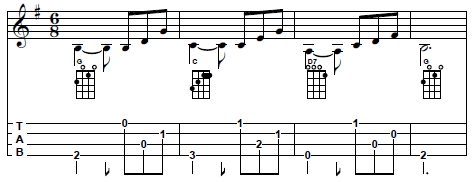
Expansion of cuatro chord families
The melodies considered for the different accompaniment schemes for strumming and for arpeggios in the previous sections are a sample of the many simple melodies that can be accompanied using only the four chords of the basic families for major and minor tones. The reason why the chords of the basic families serve to harmonize a large number of melodies is that these chords correspond to the tonal degrees (I, IV and V) of the scales corresponding to the major tonalities and minor tonalities. The knowledge of these chords and the mastery of the strumming and arpeggios considered mean a great advance towards mastery of the cuatro as an accompanying instrument, but in order to undertake the accompaniment of more elaborate melodies it is necessary to expand the basic families to incorporate other chords. The main guide for this incorporation of new chords is provided by the theory studied in the subsection dealing with the Harmonization of scales in the Chords section of this page and of the Theory page.
Expansion of cuatro chord families for major tonalities
The following table shows the result of expanding the basic family of chords for major tonalities with the nuclei corresponding to the other degrees of the scale additional to the nucleuses for degrees I, IV and V:
In this table it has been considered useful to highlight groups of cores using the following scheme:
- The nucleuses with the most pronounced shading, I-V7 and IV-I7, correspond to the chords used in the basic families, so they are often used in harmonization.
- An intermediate shading has been used for the V-II7 nucleus corresponding to the fifth degree, the most important after the first; for the VIm-II7 nucleus corresponding to the sixth degree, relative minor of the first degree and for the IIm-VI7 nucleus, corresponding second degree, relative minor of the fifth degree.These will also be found frequently.
- The nucleuses corresponding to grades III and VII, whose importance is relatively minor, has not been highlighted.
In this table the second chord of the nucleus corresponding to the seventh grade does not correspond to the seventh dominant chord of the tonic of the first chord, as is the case for the rest of the nuclei. The reason for this is that if this chord were proceeded in the same way, it would contain notes that do not belong to the major scale, so there would be no diatonic harmonization.
Examples of use of the cuatro chord families for major tonalities
It would be too extensive to give examples of use for each of the new chords contained in the family for major tonalities; we will just give examples for the chords that are considered most important in classical diatonic harmonization.
Incorporation of the nucleus corresponding to the dominant major chord (V-II7)
The dominant degree (V) of a major or minor scale is the most important after the tonic degree (I); however, in the basic family the seventh dominant chord corresponding to the fifth grade is used, not the major chord. In some melodies this major chord plays an important role. For example, in "Aloha Oe" the nucleus constituted by this chord and the seventh chord constructed on degree II (dominant dominant) are used instead of the subdominant nucleus present in the basic family. Below is an arrangement of this melody in the key of C major; in which the nucleus of the dominant tone is constituted by the G and D7 chords, and complements the tonic nucleus constituted by the C and G7 chords.
Next the execution of this arrangement on the cuatro, using the following strumming with muting in the strokes 3 and 7. To execute the muting strings are strummed downwards and its sound is muted immediately with the palm of the hand:

Incorporación del núcleo correspondiente a la tonalidad relativa menor (VIm-III7)
As we have mentioned, the basic family for the major tonalities includes only the major chords corresponding to degrees I and IV, but there are more complex melodies that will require other chords for satisfactory accompaniment. For example, a melody in a major tone can temporarily abandon its festive spirit and move into a serene mode; to do this, it will use the minor chords built on degrees II, III or VI of its scale.
Remember that in the harmonization of major scales minor chords appear as relative to major chords corresponding to degrees I, IV and V. Let us look at the case of the C major tonality:
In this section we will consider the VIm chord, relative minor of the major chord of tonic I. This chord is the tonic chord of the minor minor corresponding to degree VI, and the chords of the basic family of this tonality all belong to the expanded family of the major tonality corresponding to degree I. For example, as you can verify from the table above, the chords Am, E7, Dm and A7 that make up the basic family of the Re minor tonality are all in the extended family of the C major key. This close relationship, a consequence of the fact that the natural minor scale is formed on the sixth degree of the major scale and has exactly the same notes, leads to frequent use of the nucleus of the relative minor tonality in the harmonization of pieces in major tonalities.
The Venezuelan waltz "Brumas del Mar", whose score and tablature are shown below, is an example of how the minor relative tonality complements the major tonality:
Next the execution of this waltz on the venezuelan cuatro, using the following strumm:

Note that you must start your accompaniment on the second measure.
Incorporation of the nucleus corresponding to the minor supertonic chord (IIm-VI7)
We saw the use of this nucleus in the accompaniment of the musical phrase of measures 1 to 8 of the melody "Brumas del mar" in the key of C major. In this key the Dm (IIm) chord corresponds to the harmonization of the second degree of the scale and serves as a subdominant; the A7 (VI7) chord is the second chord of the corresponding nucleus and prepares the passage to the Dm chord. This phrase could also be accompanied entirely by the four basic chords of the key:

If you compare the result of this new harmonization with the first one, you might agree that it is more satisfactory.
Expansion of the cuatro chord families for minor tonalities
The following table shows the result of extending the basic family of chords for minor tonalities with the nuclei corresponding to the other minor natural scale degrees in addition to the nuclei for degrees I, IV and V:
As for the table of chord families for major tonalities, in this table it has been considered useful to highlight groups of nuclei using the following scheme:
- The nuclei with the most accentuated shading, Im-V7 and IVm-I7, correspond to the chords used in the basic families, so they are very often used in harmonization.
- An intermediate shading has been used for the Vm-II7 nucleus corresponding to the fifth degree, the most important after the first; for nucleus III-VII7 corresponding to the third degree, relative higher of the first degree and for nucleus bVI-bIII7, corresponding sixth degree, relative higher than the fourth degree.These will also be found frequently.
- The nucleus corresponding to grades II and VII, whose importance is relatively minor, has not been highlighted.
The chords that appear in each column of this table are the same as those that appear in this in the column corresponding to the major relative tonalities in the table for the major tonalities; however, they are now shown on the degrees of the minor scale. For example, since the A minor scale begins in the sixth degree of its relative major C scale, the Am chord that appears in the (eleventh) row corresponding to degree VIm and the (first) column corresponding to the tonality of C major in the table for families of the major tonalities now appear in the (first) row corresponding to degree I of the (sixth) column corresponding to the Am tonalitie in the table for the families of minor tonalities. The same observations that were made to form nucleus VIIm7b5-IV7 are now valid for nucleus IIm7b5-I7.
Examples of use of the cuatro chord families for minor tonalities
It would be too extensive to give examples of use for each of the new chords contained in the family for minor tonalities; we will confine ourselves to giving examples for the chords that are considered most important in classical diatonic harmonization.
Incorporation of the nucleus corresponding to the dominant minor chord (Vm-II7)
As we have mentioned on several occasions, the dominant degree (V) of a major or minor scale is the most important after the tonic degree (I); however, a minor chord built on this grade was not included in the basic family for minor shades, which we have done in the expanded table. When moving from the Im tonic chord to the dominant chord Vm, preparation II7 is usually used. When moving from the V7 chord, second of the tonic core, it can go directly; as occurs in bars 5 to 7 of the following arrangement in D minor of the dance "La Borinqueña", in which there is the transition of A7 (V7, first chord of the tonic nucleus) to Gm (Vm, second chord of the nucleus of dominant):
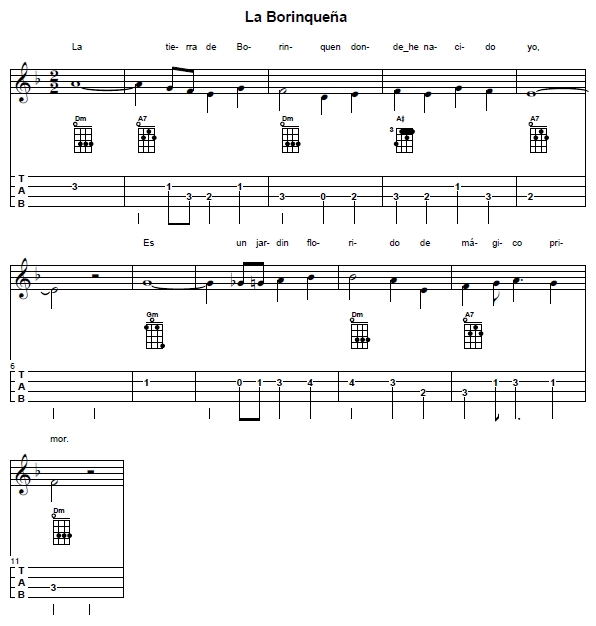
In the last section of this page, corresponding to chord inversions, we will consider the full version of this arrangement.
Incorporation of the nucleus corresponding to the major relative tonality (III-bVII7)
The basic family for the major tonalities includes only the nuclei of the minor chords corresponding to the degrees, IVm and I7, but there are more complex melodies in minor tonalities that will require other chords for satisfactory accompaniment.
Let us remember that in the Harmonization of the natural minor scale subsection of the Chords section of the Theory page we saw that in the harmonization of the natural minor scales major chords appear as relative of the minor chords corresponding to degrees I, IV and V; therefore, a melody in minor tonality can temporarily abandon its serene spirit and move into a festive mode by using these major chords.
In this section we will consider the chord IIIb, relative major of the minor chord of tonic Im. This chord is the tonic chord of the major tonalty corresponding to degree bIII, and the chords of the basic family of this tonalty all belong to the extended family of the minor tonalty corresponding to grade I. For example, as you can verify from the previous table, the chords C, G7, F and C7 that make up the basic family of the key of C major are all in the extended family of the key of A minor. This close relationship, as a consequence of the fact that the natural minor scale is formed on the sixth degree of the major scale and has exactly the same notes, leads to frequent use of the core of the relative major tonality in the harmonization of pieces in minor tonalities.
The Venezuelan Christmas carol "Niño Lindo", whose score-tablature is shown below, is an example of how the major relative tonality F complements the minor tonality Dm:
with your cuatro using the following strumming scheme for 2/4 measures:
ud.jpg)
Incorporation of the nucleus corresponding super-dominant degree (bVI-bIII7)
The beautiful "Greensleeves" melody makes repeated use of the Im-bIII-bVII-Im progression, in which the bVII subtonic chord is passed through the use of the major relative chord bIII. The following is the arrangement of this melody in the A minor key, in which this progression is constituted as follows: Am-C-G-Am:
with your cuatro using the following strumming pattern for 3/4 measures:

Incorporation of the nucleus corresponding to the semi-decreased degree (IIm7b5-I7)
The melody "Autumn Leaves" lends itself to a harmonization rich in seventh chords, among which is the IIb7b5 chord. Below is the score-tablature of this melody in the G major key:
with your cuatro using the following strum scheme for 3/4 measures:

Note that the first beat of the first measure corresponds to a silence and that the accompaniment begins in the first beat of the second measure.
The arrangement of "Autumn Leaves" which is the one of the greatest harmonic richness that we have studied up to this point, and uses the following chords:
Gm Gm7 Am7b5 BbM7 Cm7 C9 D7 EbM7 F7
It is important that we verify whether each of these chords are in what constitutes our basis for accompaniment: the harmonization of scales and chord families. Below are the chords included in the harmonization of the minor scale of the Sun and in our family of chords for the G minor tonality:

In this table we have highlighted in bold the chords used in the harmonization of "Autumn Leaves". With the exception of the C9 chord (C ninth) all the chords are in our accompaniment base. In the next three sections we will study ninth chords and other chords found in modern harmonization and add interest and beauty; but the base we have built so far will be enough for most of the most popular melodies. In fact, new chords will be obtained from the chords of this base with the addition of a new note or modification of one of their notes.
Adding notes to cuatro the triads
In the previous two sections, families of chords for major and minor tonalities were expanded by harmonizing their respective scales. There are two basic mechanisms for the creation of new chords from these chords: the addition of notes to a chord, a mechanism already used to generate seventh chords in the previous section, and the alteration of the notes of a chord.
The following diagram shows different notes that can be added to the fundamental triads to generate four note chords. Remember that the notes of the major triad correspond to degrees I, III and V (0, 4 and 7) and those of the minor triad correspond to degrees I, bIII and V (0, 3 and 7); these notes are shown in clear dashed lines.

The numbers that appear below the scale are those used for the denomination of the chords resulting from the addition of one of these notes to the triads. Note that:
- This diagram does not include notes corresponding to degrees bII (1), bV (6) and VII (11) which form strongly dissonant intervals with respect to tonic.
- The Arabic numerals in bold below the scale correspond to the expression of the Roman numerals associated to the degrees of the scale.
- Due to the limitations imposed by the number of strings of the cuatro and its reentrant tuning, the notes corresponding to degrees IX to XIII are transported to the base octave. To justify this decision consider a section of the cuatro fingerboard:

The lowest string the cuatro is the fourth. If the tonic of a chord is on this fourth string, the highest note of this chord that can be fingered with relative comfort is the note that is one octave up from this tonic, on the second string, which defines the shaded portion on the fretboard as the comfort zone for fingering. Any note outside this region will require considerable skill from the performer.
Even with the limitation imposed by the range of four frets that we will impose on the implementations of chords to be considered, their number is high; as can be seen in the chord manuals available in the literature. The seventh dominant chords are found as second chords of each of the chord nuclei contained in the extended chord families table and are used very often in practice, so they must be memorized; once memorized this same practice will permanently fix them in memory. But we are about to introduce new four-note chords that, although important, are very numerous and are not used as often in practice, so their memorization may not be justified. It is much more rational to visualize its construction on the fretboard of the ukulele using the nuclei of major and minor chords, identified in the Nuclei of chords for major and minor tonalities subsection of the Cuatro/Chords section. This ability reduces the dependence of these manuals. A table showing the most important chords considered in this work is provided in Appendix A.
The idea of having to handle the large number of chords resulting from adding to the set of chords already considered the set of chords introduced in this section and the next two sections may be intimidating. However, you should keep in mind that the new chords considered provide a richer sound to the chords on which they are built, but fulfill their same harmonic functions; therefore, initially you will be able to accompany the great majority of the popular pieces with the chords contained in the family presented by the tables of the two previous sections. As you become familiar with the new chords, you can incorporate them into your arrangements.
We will now consider each of the new four note chord types separately. To fix ideas and contrast with the generation of chords by stacking notes on the staff we used before, we will start with the seventh chords, which we already know.
Seventh chords
As we saw in the harmonization of major and minor natural scales, the seventh chords are of varied nature, since their conformation depends on the scale and the degree on which they are built.
The details of the construction of seventh chords were given in the subsection Addition of notes to a chord/Adding of notes to the triads of the Chords section of the Theory. To illustrate the application the scheme presented there to the cuatro, we will approach the construction of dominant seventh chords directly on the fretboard starting with the major triads. las triadas mayores.
Consider the following basic fingering of major chords studied earlier: 
To each of these fingerings the note corresponding to degree bVII must be added and the redundant note removed to obtain a dominant seventh chord:

Note: the tonic of each of these fingerings corresponds to a different string of the cuatro.
In the previous pages we have found numerous examples of the use of dominant seventh chords.
To visualize the construction of the minor sevenh chords on the ukulele fingerboard, consider the following basic fingerings of minor chords previously studied:

To each of these fingerings, the note corresponding to grade bVII must be added and the redundant note removed to obtain a minor seventh chord of dominant:

Note:
- The tonic of each of these fingerings corresponds to a different string of the cuatro.
- Each of these fingerings is obtained from its corresponding seventh dominant by simply lowering a semitone(moving up one fret) the note corresponding to degree III.
We have found examples of the use of dominant seventh chords in almost all examples of melodies, and of minor seventh chords in "Autumn Leaves".
Sixth chords
As seen in the subsection Adding notes to a chord/Adding notes to the triads of the Chords section of the Theory pages, the so-called sixth chords are generated by adding the note corresponding to the sixth degree of the scale to the major and minor triads.
As for the dominant seventh chords, the sixth major chords can be obtained from the basic fingerings for the major triads and the sixth minor chords can be obtained from the basic fingerings for the minor triads: to each of these fingerings must be added the note corresponding to degree VI.
For major sixth chords we have:

Note:
- The tonic of each of these digitations corresponds to a different string of the ukulele.
- Each of these digitations can also be obtained from the corresponding dominant seventh by simply lowering a semitone (moving up one fret) the note corresponding to degree bVII.
- The chord (not the digitation) B6 cannot be fingered with open notes. Its first appearance on the fretboard corresponds to the fingering A6 which starts at the second fret.
For minor sixth chords we have:

Note:
- The tonic of each of these digitations corresponds to a different string of the ukulele.
- Each of these digitations can also be obtained from the corresponding major sixth simply by lowering a semitone (moving up one fret) the note corresponding to degree III.
Let's look at a simple example of the use of the sixth major chord. The first melody we consider in the section in which the basic family of four chords was formed was "Amazing Grace", in the key of C major. Next we will consider again the simple arrangement of this melody, but with a small modification: in measure 15 (the penultimate) we will use the G6 chord instead of the G7 chord, which is justified because both are formed from the major triad G and retain its dominant function within the key of C major:
The following recording is the implementation of this arrangement using the following accompanying pattern in 3/4 rythm:

Adding notes to cuatro seventh chords
The process of adding notes to a chord can be applied repeatedly, so it is possible to generate other types of chords by adding notes to the seventh chords. This process was studied in the subsection Adding notes to a chord/Adding notes to the seventh chords of the Chords section of the Theory pages. In this section we will limit ourselves to the discussion of the chords obtained from the dominant seventh chords, which have played an important role in our construction of the chord families for the cuatro.
Another aspect that will guide our presentation of these chords, is that in addition to the limitation imposed by its reentrant tuning to the octave in which the added notes can be typed, the ukulele has an additional limitation: it only has four strings; therefore, these chords cannot be fingered in full, since they consist of five notes. It is necessary to approximate these chords by using only four notes; therefore we will be considering incomplete chords of ninth, eleventh and thirteenth.
The reduction to only four notes of the ninth, eleventh and thirteenth chords usually leads to chords that can be identified as other complete chords of four notes for the same or different tonality, some of which correspond to the types already studied but with alteration of some of its notes, subject that will be studied in the following section. The determination of an approximation of these chords with another of a unique nature that can also be fingered on the ukulele fretboard is not a trivial task. In the article "On the implementation of chords of five or more notes on the Ukulele" [N] an approach in the solution of this problem is discussed in detail; here we will limit ourselves to commenting on the results of an example considered in this article, that of determining an appropriate chord to approximate the ninth chord D9. The elimination of the note corresponding to the first degree of the ninth chord leads to the minor seventh chord with diminished fifth (half diminished chord) built on the third degree of the D tonality and also to the minor sixth chord constructed on the fifth degree of this tonality:
D9 = F#m75- = Am6
A revelation of this study is that in in your initiation to the ukulele the types of chord studied in these pages are sufficient to accompany almost any popular melody.
Altering the notes of a cuatro chord
We pointed out before that the basic mechanisms for creating new chords are two: the addition of notes to a chord, which we just studied in the previous section, and the alteration of the notes of a chord, which we will study in this section. The following figure illustrates the most common alterations:

Alteration of the note corresponding to the third degree (suspended chords)
In these chords, which were studied in the section Alteration of the notes of a chord/Alteration of the grade corresponding to the third degree of the Chords section of the Theory, la nota correspondiente al tercer grado es sustituida por la nota correspondiente al segundo o al cuarto grado, the grade corresponding to the third grade is replaced by the grade corresponding to the second or fourth grade, so that the definition of the mode (major or minor) is "suspended".
To visualize these chords on the ukulele fretboard, consider the following basic digitations of minor chords previously studied:

If the note grade corresponding to grade bIII is decreased by a semitone, the following difitations are obtained over a range of four frets:
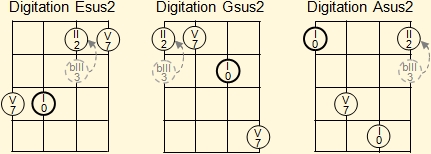
The fingering corresponding to Bsus2 requires a range of five frets.
If the note corresponding to the third degree of a major chord is increased by a semitone, a suspended fourth chord is obtained. To visualize these chords on the ukulele fingerboard, consider the following basic fingerings of major chords previously studied:

If the note corresponding to degree III is increased by a semitone, the following fingerings are obtained over a range of four frets:

Alteration of the note for the fifth grade
Triadas con quinta disminuida
If the note corresponding to the fifth grade of a minor triad is reduced by a semitone, a minor triad with diminished fifth is obtained.
Below are the chords with diminished fifth can be obtained from the basic fingerings for minor chords over a range of four frets:

Triads with augmented fifth
If the note corresponding to the fifth grade of a major triad is increased by a semitone, a triad with an augmented fifth is obtained.
Below are triads with an augmented fifth that can be obtained from the basic fingerings of major chords over a range of four frets:

Note that the first three digitations have the same conformation and only differ in the position of the root.
Alteration of the note corresponding to the seventh grade
Most of the chords that we will study in this section were already obtained by harmonizing the major scale and the minor scale by means of seventh chords, but in this section we will generate them again by altering the corresponding seventh degree note of a dominant seventh chord. This same technique can be applied to the ninth, eleventh and thirteenth chords.
If the note corresponding to the bVII degree of a dominant seventh chord is increased in one semitone, a major seventh chord is obtained.
Below are major seventh chords that can be obtained from the basic fingerings of dominant seventh chords previously studied:

A continuación se muestran acordes menores de séptima mayor que pueden obtenerse de las digitaciones básicas de acordes de séptima de dominante estudiadas con anterioridad:

Cuatro chords inversions. Equivalence of chords
We already have a wide set of chords for the accompaniment of melodies. To add more interest to this accompaniment it is convenient to exercise the ability to digitate each of these chords along the fingerboard.
Below are the different C major, C minor and C seventh dominant chord fingerings that are obtained using each of the basic fingerings.

Note that each of these sequences is repeated from the 12th fret of the ukulele. In the case of the C minor chord, the link between the different fingerings is particularly evident. The following fingerings of the F major chord can also be used to show the link of the major chords:
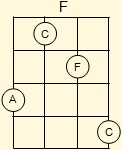
Remember that in the previous section we took the chords B, G and E as basic to reproduce the whole set of chords in different positions of the fretboard, and that the objective of the previous diagrams is to develop techniques to be able to quickly move between different inversions of the major, minor and seventh chords, which are the fundamental chords in harmonization, while playing a melody.
Below are suggested a series of exercises that will help you move between the different inversions of major, minor, and dominant seventh chords automatically. The practice of these exercises is very important, so repeat them until you can do them effortlessly. This practice is based on the previous schemes, but, as you will have noticed, in the elaboration of them certain choices were made among several possible ones. The objective of the exercise is that you can move easily between the different fingering of the chords, so do not hesitate to use the scheme that you find most satisfactory.

Remember: the objective of these practices is to achieve speed when moving between different fingerings of chord inversions. Repeat the proposed practices until you can execute them quickly and without much effort. Do not reverse the order of exercises until you meet this goal, doing so probably results in wasted time and greater effort.
Chord inversions will play an important role in the creation of solos for the ukulele, subject of the next section, especially in the technique of "melody by chords" (chord melody).
Various